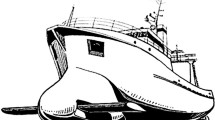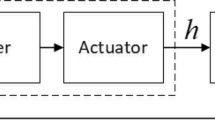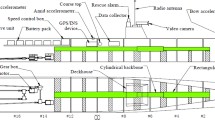Abstract
In order to raise ship energy efficiency, the possibility of wave energy recovery by a pair of coilspring connected oscillating wings for assisting ship propulsion in waves is investigated. A frequency domain hydrodynamic model based on potential theory is established to predict the effect of the oscillating wings on the ship in regular waves, in terms of reducing wave-added resistance and improving seakeeping performance. The proposed linear model is suitable for short-term prediction based on conventional spectral analysis techniques, thus making it possible to evalute the long-term performance of oscillating wings for assisting ship propulsion at actual seas based on wave statistics. A sample containership is adopted to study the performance of the proposed concept. The results show that the oscillating wings can effectively reduce the added resistance of the ship at actual seas. The feasibility of this green ship technology is proved.
Similar content being viewed by others
References
International Maritime Organization (IMO). Amendments to the annex of the protocol of 1997 to the international convention for the prevention of pollution from ships (inclusion of regulations on energy efficiency for ships in MARPOL Annex VI) [EB/OL]. (2009-1-6). http://www.imo.org/OurWork/Environment/pollutionprevention/airpollution/documents/technicalandoperationalmeasures/mepc.214(63).
Hochkirch K, Bertram V. Engineering options for more fuel efficient ships [C]//Proceedings of First International Symposium on Fishing Vessel Energy Efficiency. Vigo, Spain: Local Organizing Committee, 2010: 1–11.
Isshiki H. A theory of wave devouring propulsion: Thrust generation by a linear wells turbine [J]. Jouranl of Society of Naval Architects of Japan, 1982, 151: 54–64.
Terao Y. Wave devouring propulsion system from concept to trans-Pacific voyage [C]// International Conference on Ocean, Offshore and Arctic Engineerin. Honolulu, USA: ASME, 2009: 119–126.
Wu T Y. Extraction of flow energy by a wing oscillating in waves [J]. Journal of Ship Research, 1972, 14(1): 66–78.
Maimun A, Yaakob O, Mdkamal A, et al. Seakeeping analysis of a fishing vessel operating in Malaysian water [J]. Jurnal Mekanikal, 2006, 22: 103–114.
Denis S M, Pierson W J. On the motion of ships in confused seas [C]//Transactions of the Society of Naval Architects and Marine Engineers. USA: Local Organizing Committee, 1955: 386–435.
International Towing Tank Committee (ITTC). Report of Seakeeping Committee [C]//Proceedings of 12th International Towing Tank Conference. Rome, Italy: ITTC, 1969: 1–10.
Tsujimoto M, Kuroda M, Shibata K, et al. On a calculation of decrease of ship speed in actual seas [J]. Journal of Japan Society of Naval Architects and Ocean Engineers, 2009, 9: 79–85.
Liu S K. Numerical simulation of large amplitude ship motions and applications to ship design and safe operation [D]. Athens: School of Naval Architecture and Marine Engineering, National Technical University of Athens, 2011.
National Maritime Research Institute. Data base of winds and waves [EB/OL] (2009-01-06). [2010-01-23]. http://www.nmri.go.jp/wavedb/download/WWDBE-ver1.4.pdf.
Author information
Authors and Affiliations
Corresponding author
Additional information
Foundation item: the “Knowledge-Based Ship Design Hyper-Integrated Platform (KSHIP)” of Minister of Education and Minister of Finance of China (No. ZXZY019) and the Project of State Key Laboratory of Ocean Engineering in Shanghai Jiaotong University (No. GKZD010056-3)
Rights and permissions
About this article
Cite this article
Feng, Py., Ma, N. & Gu, Xc. Long-term performance prediction of oscillating wings for assisting ship propulsion at actual seas. J. Shanghai Jiaotong Univ. (Sci.) 18, 486–492 (2013). https://doi.org/10.1007/s12204-013-1412-3
Received:
Published:
Issue Date:
DOI: https://doi.org/10.1007/s12204-013-1412-3




